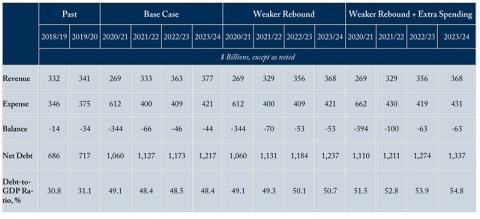From: Alexandre Laurin, William B.P. Robson and Miles Wu
To: Canadians Concerned about Government Debt
Date: July 20, 2020
Re: Was Ottawa’s frightening fiscal snapshot a prelude to something worse?
The July 8 federal fiscal snapshot unveiled numbers so awful that a reasonable person might suspect an expectations-management exercise.
The projected deficit of $343 billion for this year was nearly $100 billion worse than the Parliamentary Budget Officer’s June 18 projection, and $40 billion worse than the most pessimistic numbers circulating. If realized, that deficit would be the same as last year’s total federal revenues. It would mean that the federal government borrows more than half the money it spends this year. It would increase Ottawa’s net debt by almost half in one year.
Adding to the impression of an unfolding fiscal catastrophe was the absence of commentary in the snapshot about the perils of this path and how the federal government plans to get off it. Avoiding some future combination of drastic spending cuts and tax hikes will take more than good luck.
Private sector forecasters anticipate a relatively strong rebound in 2021: their projections for nominal GDP growth average almost 8 percent. That, plus continued low interest rates, a timely wind-down of emergency spending, and restraint in the federal government’s operating costs,
Source: Authors’ calculations from July 8 Economic and Fiscal Snapshot. Weaker rebound: 20 percent weaker recovery than in the baseline. Extra Spending: $50 billion more this fiscal year, $30 billion next year, $10 billion per year over the next three.
But a strong rebound is not a given – aside from the potential for resurgences of COVID-19 abroad and here in Canada, concerns about the consequences of out-of-control federal finances will sap the confidence of investors and business managers.
While interest rates are likely to stay low for now, there’s an element of risk there, too. Combined federal and provincial net debt is set to increase by more than 25 percent of GDP this year. While the long-term outlook for provincial governments’ finances was grim even before the pandemic, the fiscal prudence of past federal governments had underpinned solid credit ratings for senior governments generally. As the downgrade of Ottawa’s debt by Fitch in June highlighted, bottom-line considerations have been less salient for the current federal government.
Which gets us to the most critical assumptions of all – that emergency spending will wind down in a timely way, and the government will address the recent rapid growth of other program spending.
Perhaps those things will happen. Perhaps the snapshot’s awful numbers are setting us up to celebrate a final deficit less than $340 billion. Its projections for the Canada Emergency Wage Subsidy anticipated the July 13 announcement of the program’s extension, but absent long-awaited changes to its eligibility criteria, may still be high. There might be other padding in the numbers – not least a $9 billion boost to baseline spending since the fall update, of which almost half is “non-announced measures.”
But an alternative explanation for the awful numbers is that they are softening us up for yet more spending and borrowing still to come. Extensions to the CERB, and continued growth in the federal government’s operating costs and other program spending could easily produce deficits of $50-$100 billion in fiscal 2021/22 and beyond – and a continued rise in the debt ratio.
If that happens, pressure for tax increases and cuts to other federal programs, such as transfers to the provinces, will grow. That is an unwelcome prospect. Tax increases, whether on Ottawa’s part or by provinces struggling with healthcare and social assistance costs, will undermine economic growth, further exacerbating the adverse debt dynamics. We have plenty of evidence from our own past and from other countries that restraining the federal government’s own programs, especially its rapidly growing operating costs, would be less damaging to growth, and more effective in achieving fiscal stability.
Canadians would be far better off if the next federal budget, which should be no later than this coming September, confirmed a shift to a lower-spending, lower-borrowing government. Until then, it is reasonable to worry that the awful numbers in the fiscal snapshot are a prelude to worse in the years ahead.
Alexandre Laurin is Director of Research at the C.D. Howe Institute, where William Robson is CEO and Miles Wu is a Researcher.
To send a comment or leave feedback, email us at blog@cdhowe.org.
The views expressed here are those of the authors. The C.D. Howe Institute does not take corporate positions on policy matters.






